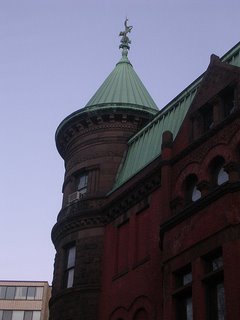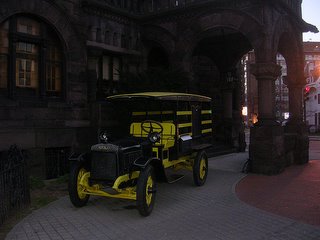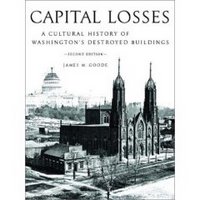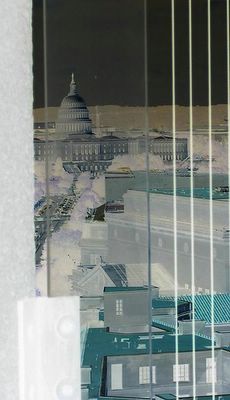OF URGENT IMPORTANCE: Preserving the Public's Access to the Historic Heurich House

YOU MIGHT RECOGNIZE THE HEURICH HOUSE if you frequent Dupont Circle. But if you aren’t careful, it can be easy to miss. Although its pointy copper turret towers over the intersection of New Hampshire Avenue and 20th Street NW, the late-19th century “Brewmaster’s Castle” itself is dwarfed by surrounding Cold War-era apartment houses and office buildings. But yet there it sits, a reminder of a bygone era in the history of Washington, D.C. It is also a physical reminder of my family’s roots in this city. Although the Grass family didn’t build Christian Heurich’s landmark mansion, my great-great grandfather, August Grass, carved its magnificent interior -- the most intact Victorian house anywhere in the United States.
But in about 20 days time, the Brewmaster’s Castle -- which has been in the public domain for the past half century as a museum and city historical archive -- may be lost, forced to be sold to the highest bidder, converted into a private club, offices, condos, who knows ...
BEFORE I GET INTO REASONS WHY THE HEURICH HOUSE MATTERS, let me quickly summarize its predicament: After the Historical Society of Washington, D.C., was about to sell the Heurich House to a restaurateur in 2003, the Heurich family spearheaded a movement to save the house by creating the Heurich House Foundation, a 501(c)(3) not-for-profit organization to keep the house open to the public. The foundation had to borrow money
 to purchase the property and now, increasing interest rates have forced the need for the foundation to quickly raise $250,000 by Feb. 15, or the foundation will be forced to sell the house or face foreclosure. By the end of the year, an additional $1,750,000 must be raised to reduce enough of its debt so it can be completely self-supporting.
to purchase the property and now, increasing interest rates have forced the need for the foundation to quickly raise $250,000 by Feb. 15, or the foundation will be forced to sell the house or face foreclosure. By the end of the year, an additional $1,750,000 must be raised to reduce enough of its debt so it can be completely self-supporting.If you have money to give, you can send a tax-deductible donation:
The Brewmaster’s Castle
1307 New Hampshire Ave. NW
Washington DC 20036
To learn more, you can visit www.BrewmastersCastle.com.
SO WHY SHOULD THE HEURICH HOUSE BE SAVED? While it’s easy to recognize the significance of the Brewmaster’s Castle on its own (gorgeous, well-preserved exterior and interior architecture; D.C.’s first fireproof residence; home to master brewer Christian Heurich, who was the city’s largest landowner a century ago), you must understand the Heurich House in context of the evolution of the Dupont Circle neighborhood and Washington, D.C., as a whole.
The house, with its original furnishings and decorations, is a living time machine to the waning days of Washington’s Gilded Age, the time after the Civil War when the nation’s capital was transformed from a sleepy town along the Potomac to a real functioning city. This transformation was made possible by the free-flow of fortunes coming into and going out of the city by the nation’s entrepreneurs — some who might make Jack Abramoff’s influence peddling of recent years look like casual child’s play.
ALL YOU NEED TO DO is look north across New Hampshire Avenue where it intersects O Street NW. It was on that corner where the magnificent mansion of George Hearst once stood at 1400 New Hampshire Ave.
 (Today you might better know it as that ugly office building, pictured at left, that is home to the bed bar and lounge Cloud.) George Hearst was one of those entrepreneurs who went out West, struck it rich in the mining industry, bought a newspaper (the San Francisco Examiner) and was appointed a senator. In 1886, the crude Hearst and his much-loved wife, Pheobe Apperson Hearst, bought a Colonial Revival home from outgoing Cleveland administration Treasury Secretary Charles Fairchild in what was then remote Dupont Circle. The Hearsts remodeled the home in the Richardsonian Romanesque style ... its massive stone arch porch and balconies would later be echoed across the street in the Heurich House’s porte cochere when the brewmaster built his Dupont mansion in 1892-94. (One of Dupont’s last remaining landmark Richardsonian Romanesque mansions is the Boardman House, which houses Iraq’s P Street embassy.)
(Today you might better know it as that ugly office building, pictured at left, that is home to the bed bar and lounge Cloud.) George Hearst was one of those entrepreneurs who went out West, struck it rich in the mining industry, bought a newspaper (the San Francisco Examiner) and was appointed a senator. In 1886, the crude Hearst and his much-loved wife, Pheobe Apperson Hearst, bought a Colonial Revival home from outgoing Cleveland administration Treasury Secretary Charles Fairchild in what was then remote Dupont Circle. The Hearsts remodeled the home in the Richardsonian Romanesque style ... its massive stone arch porch and balconies would later be echoed across the street in the Heurich House’s porte cochere when the brewmaster built his Dupont mansion in 1892-94. (One of Dupont’s last remaining landmark Richardsonian Romanesque mansions is the Boardman House, which houses Iraq’s P Street embassy.) If you have a copy of “Capital Losses” lying around (which is where I’m getting much of my information here) or are in a local bookstore and see it, page through to find photos of the Hearst’s home. It’s truly decadent in its interior, which also boasted one of the city’s first modern bathrooms.
If you have a copy of “Capital Losses” lying around (which is where I’m getting much of my information here) or are in a local bookstore and see it, page through to find photos of the Hearst’s home. It’s truly decadent in its interior, which also boasted one of the city’s first modern bathrooms. George Hearst died in 1891, but his wife lived there until 1902, when the house was sold to the government of Italy, which used the mansion as its embassy. The house was torn down in 1964, as the city’s central business district spread west and north from Farragut Square.
If the name Hearst and San Francisco Examiner sound familiar, they should. George Hearst’s son, William Randolph Hearst, built his newspaper empire and later his own castle on the California coast at San Simeon.
 AROUND THE SAME TIME, ALEXANDER GRAHAM BELL and his wife had a little too much space at their roomy home on Scott Circle. So they hired the highly regarded architectural firm Hornblower and Marshall to build them a home in 1892 more tailored to their tastes at 1331 Connecticut Ave. If you walk on the eastern side of Connecticut Avenue between Dupont Circle and N Street NW, you will spot a dry cleaners a few doors down from Heritage India, Café Citron and the Big Hunt. That is where the inventor of the telephone (at left, with Helen Keller in an image from Keller's 1905 biography) lived while he studied hearing, the deaf and the hard-of-hearing at the Volta Bureau in Georgetown. But Bell's home included a special entertainment wing where he hosted his winter “Wednesday Evenings,” where he gathered the top scientists and thinkers of the day. That home, where Bell invented an early form of air conditioning, was razed in 1930.
AROUND THE SAME TIME, ALEXANDER GRAHAM BELL and his wife had a little too much space at their roomy home on Scott Circle. So they hired the highly regarded architectural firm Hornblower and Marshall to build them a home in 1892 more tailored to their tastes at 1331 Connecticut Ave. If you walk on the eastern side of Connecticut Avenue between Dupont Circle and N Street NW, you will spot a dry cleaners a few doors down from Heritage India, Café Citron and the Big Hunt. That is where the inventor of the telephone (at left, with Helen Keller in an image from Keller's 1905 biography) lived while he studied hearing, the deaf and the hard-of-hearing at the Volta Bureau in Georgetown. But Bell's home included a special entertainment wing where he hosted his winter “Wednesday Evenings,” where he gathered the top scientists and thinkers of the day. That home, where Bell invented an early form of air conditioning, was razed in 1930. I COULD GO ON AND ON about the neighborhood’s forgotten history -- I would suggest you read up on fateful history of the McLeans, whose Eye Street Florentine villa, complete with a 30-foot-high first floor devoted only to entertaining, took up the entire south side of McPherson Square ... Edward McLean, who mismanaged and drove The Washington Post to bankruptcy in the years after the Teapot Dome scandal, and his wife, Evalyn Walsh McLean, the so-called Queen of Diamonds who owned the Hope Diamond, squandered their combined $100 million fortune on travel and entertaining -- but I’ll get to my point.
I COULD GO ON AND ON about the neighborhood’s forgotten history -- I would suggest you read up on fateful history of the McLeans, whose Eye Street Florentine villa, complete with a 30-foot-high first floor devoted only to entertaining, took up the entire south side of McPherson Square ... Edward McLean, who mismanaged and drove The Washington Post to bankruptcy in the years after the Teapot Dome scandal, and his wife, Evalyn Walsh McLean, the so-called Queen of Diamonds who owned the Hope Diamond, squandered their combined $100 million fortune on travel and entertaining -- but I’ll get to my point.I think it's safe to say that the Heurich House is the last remaining intact historic house in the downtown area to not only have its original furnishings in place but also be directly connected to its original owners. Sure the Octagon House and Decatur House are certainly older than the Heurich House, but those buildings have changed owners, caretakers, etc. Even the White House is not an original building -- its walls date to 1792, but its innards were scooped out during the Truman administration for structural rebuilding.
Though years of careful stewardship, the Heurich House is about all the downtown area has as a 21st century reminder of late 19th century residential Washington. Christian Heurich wasn’t a politician ... he wasn’t a mining magnate, nor a robber baron. He was a successful businessman and fine citizen of the District, one who built a brewery (where the Kennedy Center stands today) as part of what was once Washington’s largest industry. He was also an upstanding figure in the German-American community in 19th century Washington. (Like many German immigrants, my family settled in Hamburg -- today’s Foggy Bottom -- in the 1860s. My late grandfather and late great uncle grew up in what is now Kinkead’s restaurant on Eye Street, just west of the intersection of 20th Street NW and Pennsylvania Avenue.)
BECAUSE OF MY GREAT-GREAT GRANDFATHER’S signature woodcarving inside the Heurich House, I have a vested interest in the house remaining open to the public, preserved as it is, a time capsule of 1890s Washington. The nation’s capital is very much a city of outsiders and transplants (me included ... I grew up in Michigan). Those of you out there reading this who are not native Washingtonians, I hope you take an interest in this local landmark.
I hope that the Brewmaster's Castle can be saved and remain in the public domain. But time is limited.
First three images photographed this morning by yours truly, posted on Flickr.



3 Comments:
That's empassioned. Someone should put it in the bloglog or something.
Actually, thanks for bringing it to my attention. I know that landmark well and shall be making a donation.
Thanks, Kathryn. I just returned from the emergency meeting to save the house and there is a great crew of people who have gathered who are determined to save the house. There is likely to be a larger open house event Friday night. I'll post details when I get them.
I firmly imagine that the material supplied is relevant to absolutely everyone . Thank you so much .
fort worth locksmith
Post a Comment
<< Home